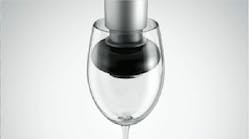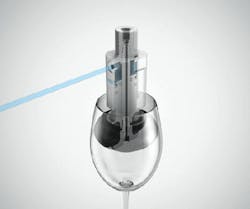Handling fragile workplaces, such as drinking glasses, plastic or glass bottles, and other items with circular openings can be tricky. DHEB series of bellows grippers from Festo can be used across a variety of processing and manufacturing industries to avoid breakage and make smooth, controlled transfers.
DHEB grippers employ flexible bellows that expand in diameter when actuated by an integral pneumatically driven piston, to securely grip the interior surface of a
work piece.
The single-acting devices are simple in design and control. When their air supply port is pressurized, an internal piston draws a wedge up or down within a rubber bellow, causing it to deform outwards to meet and conform with the interior contour of the work piece, such as the neck of a bottle. This provides a secure but gentle air-tight grip, which is maintained until the air supply port is exhausted, whereupon the force of the bellows returning to their original shape pushes the piston back into its initial position.
Two versions can handle different machine actions. One uses an upward piston stroke to deform and expand the bellows, while the other uses a downward stroke. The grippers are not limited to gripping the inside of work pieces — multiple units can be configured for grasping external surfaces, such as the edges of a printed circuit board.
The compressed air supply for the gripper can be applied via a side port on the body of the gripper, or via a connector at the top of the unit. A variant of the side port version provides a straight-through path from the top connector to a port on the underside of the piston. This allows air to be injected to cool or clean the work piece; air or vacuum can be employed to check the work piece for leaks; or fluid can be introduced for disinfection or filling purposes. Any of these actions can be performed during work piece transportation.
DHEB series grippers are available in 11 sizes, from 8 to 63 mm. The smallest is suitable for work piece diameters from 8 to 11 mm, while the largest can accommodate work piece diameters from 66 to 85 mm. Depending on factors such as friction and the shape of work piece, the largest grippers can accommodate work piece weights as high as 52 kg.
All models are designed for use with a standard supply of filtered compressed air, with a nominal operating pressure of 4 to 8 bar. To reset the bellows to their unexpanded form, the pressure to the unit’s air supply port simply needs to be reduced to 1 bar or less. Opening and closing times depend on the size of the bellows — the 8 mm model for example, opens in 10 msec and closes in 30 msec.
The bellows come in two materials. Silicone bellows have a long service life — up to 1 million cycles — and an operating temperature range of –70 to 200°C. They are also approved by the FDA for use in food processing applications. For applications demanding a higher coefficient of friction — such as internally gripping heavy straight-sided work pieces, or when the work piece might subsequently be painted or coated — bellows manufactured from ethylene propylene synthetic rubber (EPDM) are available. They have a service life of about 0.5 million cycles, and a temperature range of –50 to 140°C.
DHEB grippers can be equipped with magnetoresistive or reed switches to sense the upper and lower positions of the internal piston, and provide control feedback on the state of the gripper bellows. The switches are self-aligning and mounted on an external sensor rail secured to the body of the unit.
For more information, visit bit.ly/hp213festo.


